List of Contents
Robotic Platform Market Size and Forecast 2025 to 2034
The global robotic platform market size was estimated at USD 10.6 billion in 2024 and is predicted to increase from USD 11.23 billion in 2025 to approximately USD 18.83 billion by 2034, expanding at a CAGR of 5.91% from 2025 to 2034. The increasing need for industrial automation, advancements in technology, rising adoption of IoT, and growth of e-commerce boost the market growth
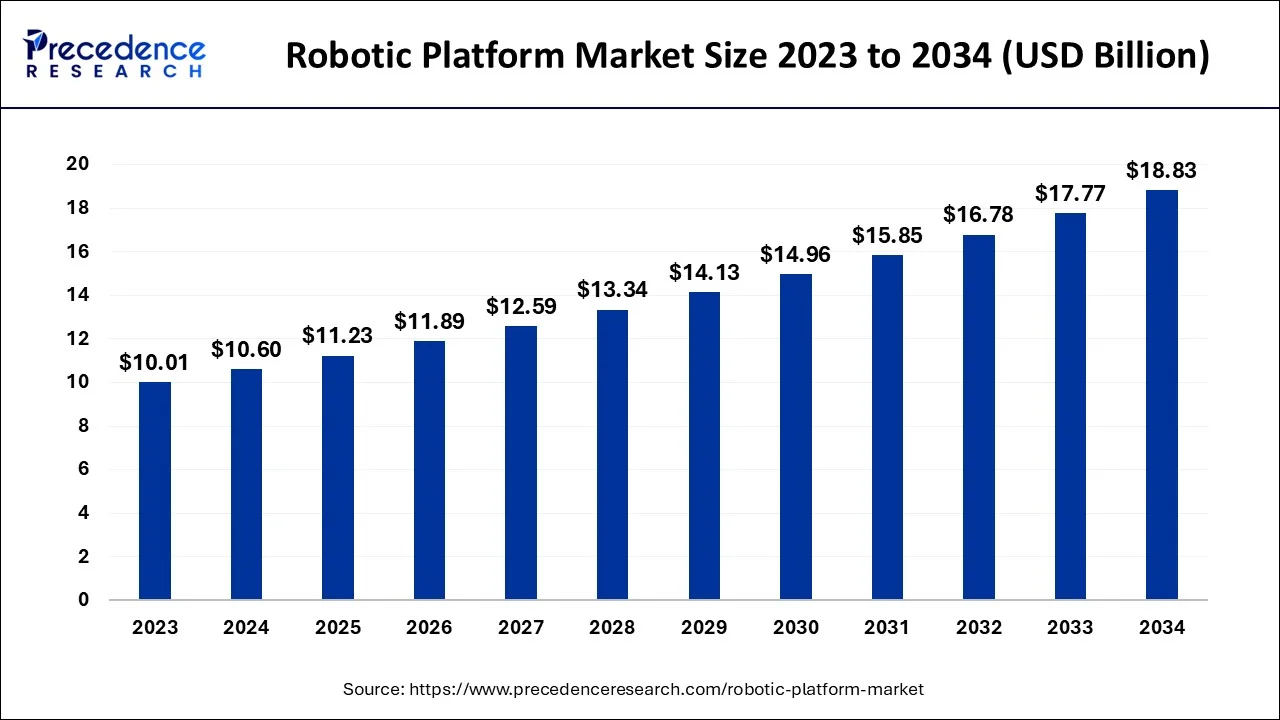
Robotic Platform Market Key Takeaways
- In terms of revenue, the global robotic platform market was valued at USD 10.6 billion in 2024.
- It is projected to reach USD 18.83 billion by 2034.
- The market is expected to grow at a CAGR of 5.91% from 2025 to 2034.
- North America dominated the robotic platform market with the largest market share of 36% in 2024.
- Asia Pacific is expected to grow at a solid CAGR of 8.04% during the forecast period.
- By robot type, the industrial robots segment accounted for the largest market share of 67% in 2024.
- By robot type, the service robots segment is expected to expand at the fastest growth rate during the forecast period.
- By deployment, the on-premises segment dominated the robotic platform market in 2024.
- By deployment, the cloud segment is expected to grow significantly in the coming years.
- By type, the stationary segment led the market with the largest share in 2024.
- By type, the mobile segment is projected to register the fastest growth during the foreseeable period.
- By end-user, the manufacturing segment held the largest share of the market in 2024.
- By end-user, the healthcare segment is expected to expand at a significant pace throughout the forecast period.
AI Impact on the Robotic Platform Market
Integrating artificial intelligence (AI) algorithms into robots enables them to learn from experience, make decisions on the basis of data, and adapt to new situations. Machine learning, natural language processing, and computer vision are fundamental to smart robotic systems. These AI technologies analyze data and recognize patterns, leading to enhanced capabilities and improved robot performance over time.
- In January 2024, the Korea Institute of Machinery and Materials (KIMM) unveiled its artificial intelligence (AI) technology for robot work that can be applied to manufacturing processes. This AI solution is crafted to revolutionize automobile production, machine part production, and assembly, among other production procedures.
U.S. Robotic Platform Market Size and Growth 2025 to 2034
The U.S. robotic platform market size was exhibited at USD 2.67 billion in 2024 and is projected to reach around USD 4.85 billion by 2034, poised to grow at a CAGR of 6.15% from 2025 to 2034.
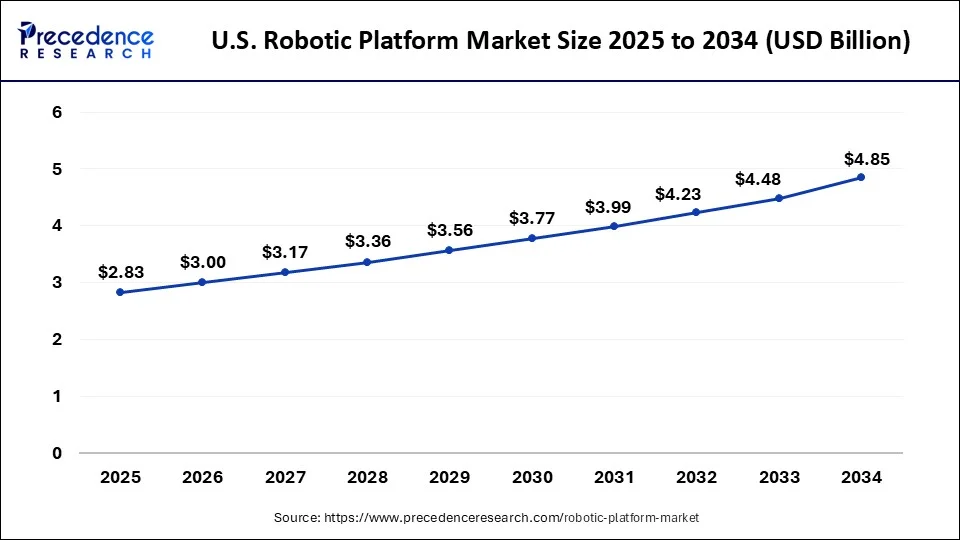
North America dominated the robotic platform market with the largest share in 2024. This is primarily due to the high adoption of new technologies and the rising focus on automation in many industries, such as healthcare, defense, manufacturing, and transportation. Robotic platforms increase productivity and efficiency in industrial procedures by reducing possible errors. Countries such as the U.S. and Canada are investing heavily in robotics research and development. In addition, there is a great demand for robots in the region's healthcare and defense sectors.
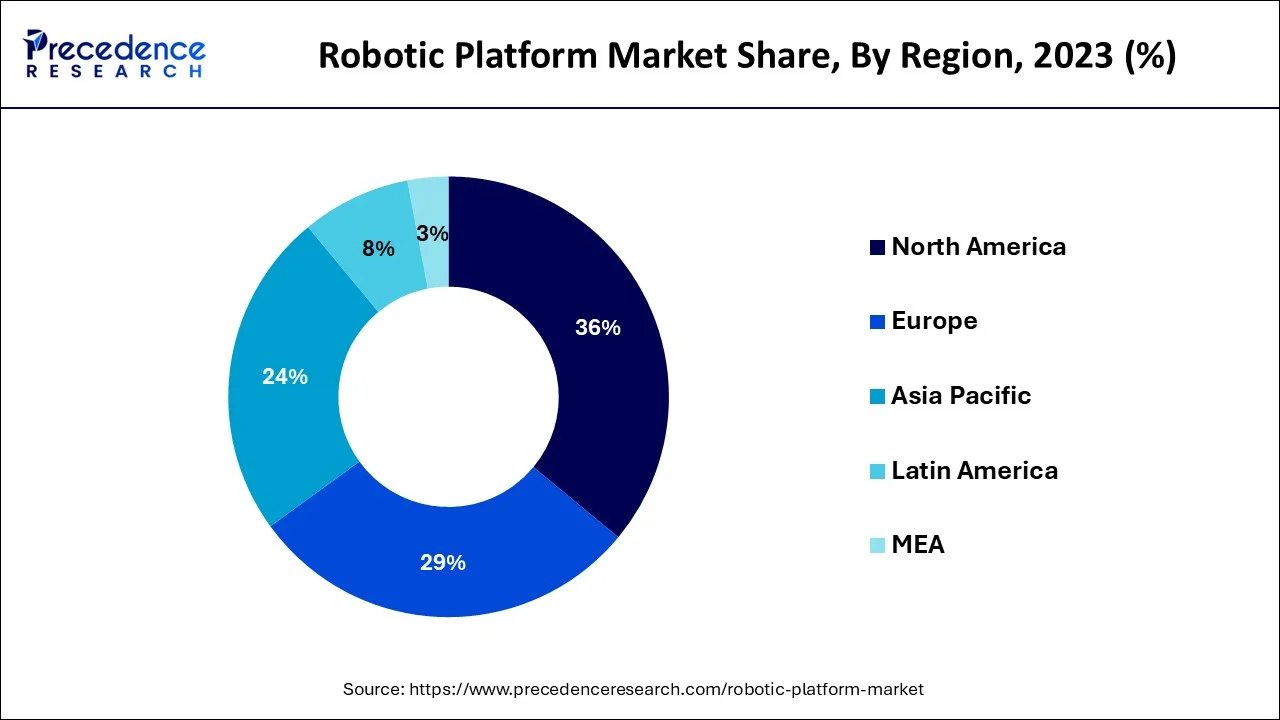
Asia Pacific is expected to witness the fastest growth in the market in the upcoming period due to factors such as growing industrialization, rising use of robotics in manufacturing industries, rising adoption of AI technologies, and the increasing need for automation. China, Japan, India, and South Korea have been at the forefront of using advanced robotic platforms. Several manufacturing industries in the region, especially electronics, automobile, and logistics, have recognized the importance of robotics in automation, thus contributing to the market growth.
Market Overview
A robotic platform is a system on which frameworks are built to support the functions and activities of robots. The platform's proficiencies and limitations are determined by its design, R&D, and manufacturing. The robotic platform market is expanding rapidly due to the rising need for automation across various industries, such as healthcare, transportation, and manufacturing, to improve efficiency and flexibility and reduce labor expenses.
Platforms used to build and test robotics applications:
| Platforms | Application |
| Google ROBEL | ROBEL is an open-source platform of cost-effective robots designed to aid research and development of hardware in the real world |
| Microsoft AirSim | This platform captures data for models from wheeled robotics and aerial drones to static IoT devices |
| Microsoft AirSim | This platform captures data for models from wheeled robotics and aerial drones to static IoT devices |
| Apollo Baidu | This open and secure software platform enables the development of autonomous driving systems through on-vehicle and hardware platforms |
| NVIDIA Isaac | It is a cloud-based robotics integrated development platform, which allows developers to develop, test, and deploy robotics applications and build intelligent robotics functions |
Robotic Platform Market Growth Factors
- Increased Need for Automation: To optimize production processes and improve efficiency, the need for automation is increasing in manufacturing, logistics, healthcare, and other industries. However, robots help in automating several industrial procedures.
- Labor Shortages: The lack of availability of skilled workers across diverse sectors is compelling organizations to incorporate automation.
- E-commerce Growth: The e-commerce industry heavily uses advanced solutions, including autonomous mobile robots (AMRs), to improve supply chain management. Thus, the rapid expansion of the e-commerce industry propels the market.
Market Scope
| Report Coverage | Details |
| Market Size by 2034 | USD 18.83 Billion |
| Market Size in 2025 | USD 11.23 Billion |
| Market Size in 2024 | USD 10.6 Billion |
| Market Growth Rate from 2025 to 2034 | CAGR of 5.91% |
| Largest Market | North America |
| Base Year | 2024 |
| Forecast Period | 2025 to 2034 |
| Segments Covered | Robot Type, Deployment, Type, End-user, and Regions |
| Regions Covered | North America, Europe, Asia-Pacific, Latin America and Middle East & Africa |
Market Dynamics
Driver
Rapid adoption of robots
Robot adoption can be referred to as integrating robotics into various facets of industries, ranging from manufacturing to supply chain. Labor safety issues, automation requirements, and rising labor and energy costs are major factors boosting the adoption of robots in various industries. However, robots support process automation, eliminate errors, and enhance production speed, thus improving quality, increasing accuracy and production scalability, and reducing labor costs.
Restraint
Data security and increasing cyberattacks
The increasing risk of cyberattacks poses a significant threat to the robotic platform market. Robots gather and stream confidential information among various components. This makes them susceptible to cyber threats. Robots also expose organizations to hacking if hackers control them. Therefore, it is crucial to mitigate these risks through more stringent security regimes, constant updates, as well as testing software.
Opportunity
Government initiatives
Government and private entities are collaborating to develop innovative solutions. In addition, government entities are investing heavily in robotics research and development to maximize the potential applications. This financial backing from the government also encourages tech companies to innovate by introducing advanced robots that minimize the possibility of errors.
- The Draft 'National Strategy for Robotics' aims to establish India as a global leader in robotics by 2030 to realize its transformative potential. It also builds upon Make in India 2.0.
- Japan's New Robot Strategy goal aims to make the country world's No. 1 robot innovation hub. According to the International Federation of Robotics, the Japanese government has offered about USD 930.5 million in support in 2022.
Robot Type Insights
The industrial robots segment accounted for the largest share of the market in 2024. This is mainly due to their enhanced functionality, effectiveness, and adaptability in a range of industrial applications. These robots have the ability to handle complex tasks across several industries, from the production line in manufacturing industries to the inspection of the quality of drugs in the pharmaceutical industry.
They help in assembly lines, surgeries, warehouse management, crop monitoring, planetary exploration, streamlining processes, enhancing efficiency, and performing tasks in hazardous or challenging environments. Industrial robots are automated, programmable, and can move on three or more axes. The rising industrialization worldwide is further boosting the usage of robots.
- According to the World Robotics 2024 report by the International Federation of Robotics (IFR), the operational stock of industrial robots has increased by 10%, with 4.28 million units in use around the world.
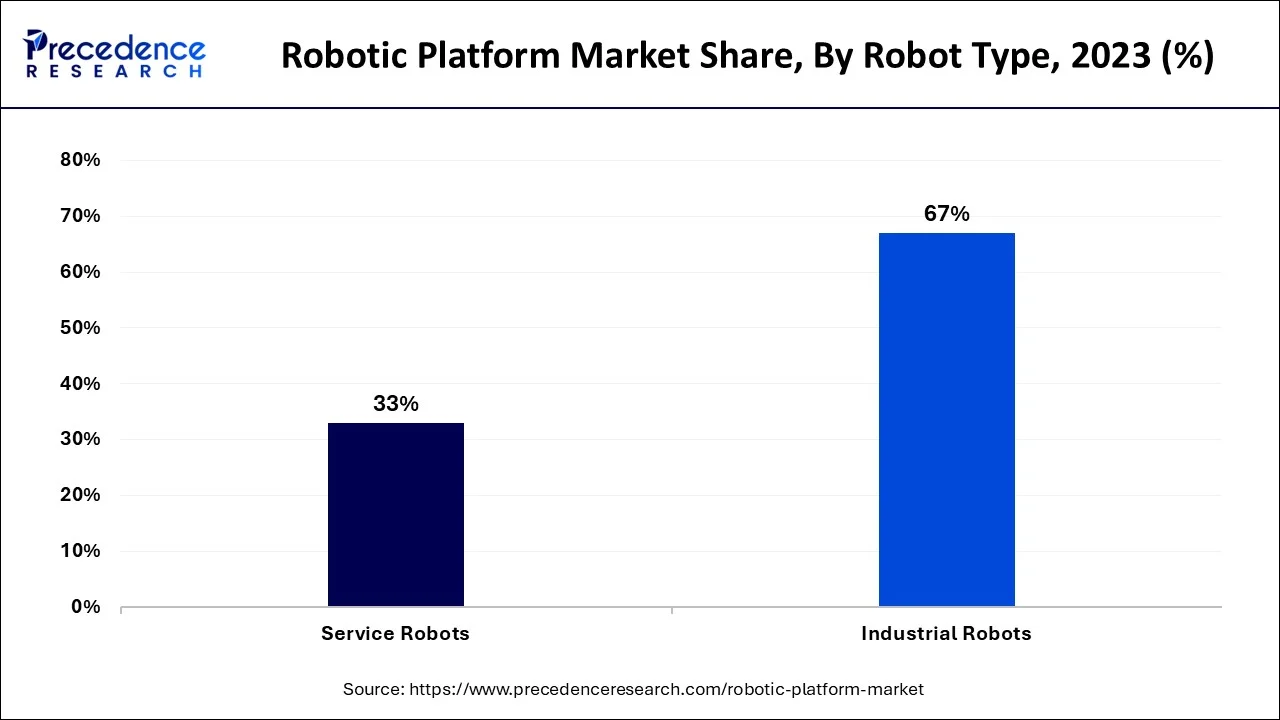
The service robots segment is expected to expand at the fastest growth rate in the robotic platform market during the forecast period. A service robot is a robot used for carrying out useful activities for people or equipment. These robots handle complex functions more efficiently, such as navigating dynamic environments or cooperating with customers in real-time. Service robots support human beings by performing dirty, dull, distant, dangerous, or repetitive jobs. They can assist individuals with disabilities, promoting greater independence and inclusion.
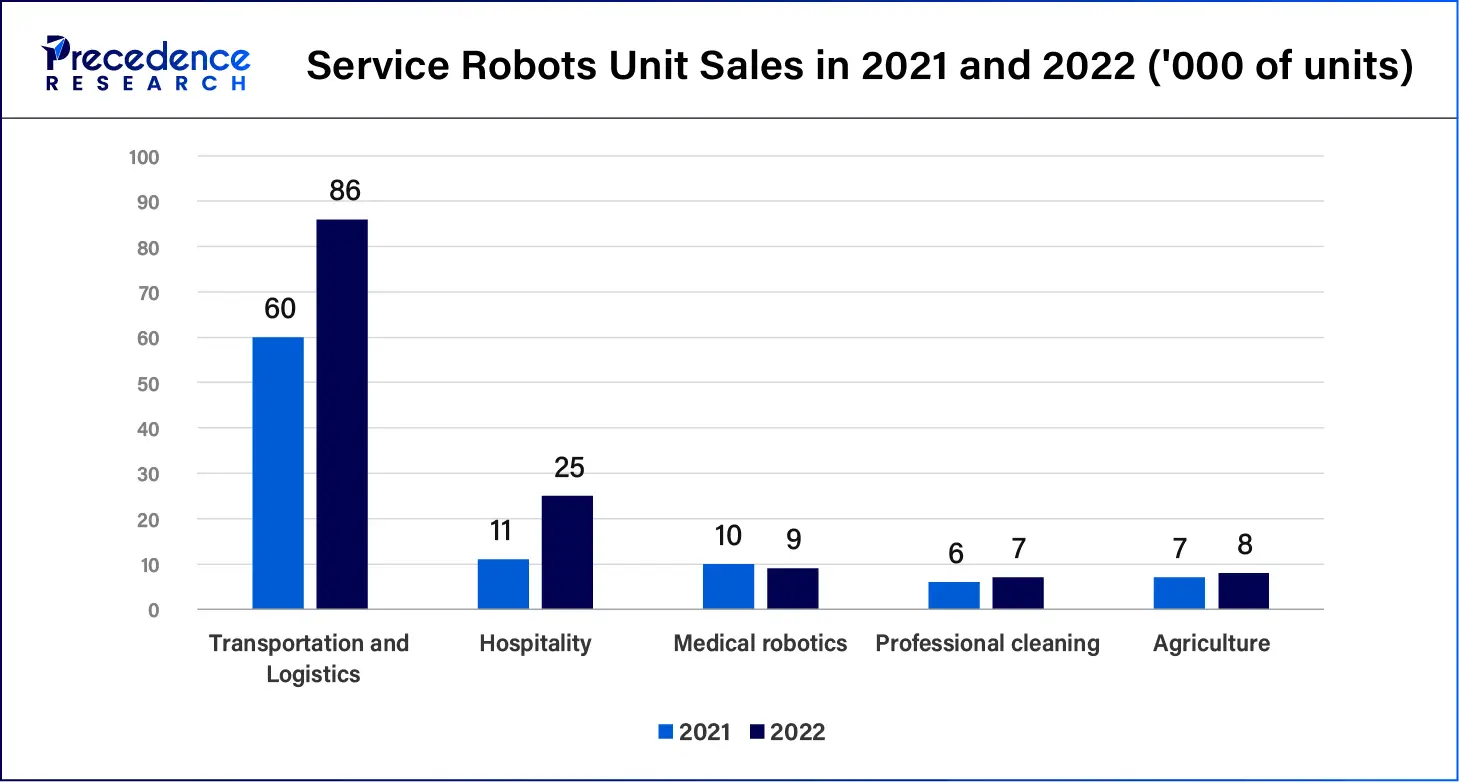
Deployment Insights
The on-premises segment dominated the robotic platform market with the largest share in 2024. On-premise robots can be mounted within an organization and managed onsite rather than being in the shared cloud or both. The benefit of on-premises systems is that they do not depend on the Internet, which eliminates the possibility of Internet failures or slow connections affecting the robot's work. On-premises robots are fitted at the client location and controlled through a network connection for each machine. Robots can perform repetitive tasks more efficiently than humans, increasing output and reducing costs.
- In February 2022, Formant unveiled an on-premise robot to meet the growing needs of enterprises.
The cloud segment is expected to grow significantly in the coming years. Cloud robotics combines applications of cloud computing, cloud storage, and other over-the-internet technologies relevant to robotics. The advantage is the opportunity to deliver significantly large amounts of data directly to the robotic devices without embedding it within the built-in memory.
Predictive analytics, which is made possible through cloud integration, helps companies predict maintenance needs, reducing downtime and repair costs. They can also use cameras and sensors to identify defects and adjust manufacturing processes. They can also be remotely monitored and controlled.
- In May 2024, Vention launched new cloud robotics and AI capabilities to enhance the efficiency of the design of robotic cells.
- In March 2023, a Hong Kong-based robotics developer launched an Agnostic Robotic Control System (ARCS) powered by Microsoft Azure cloud technology.
Type Insights
The stationary segment led the robotic platform market with the largest share in 2024. Robots that are fixed to the ground, ceiling, or some other surface are known as stationary robots. These robots cannot move. They are frequently used as robotic arms mainly for operations such as picking and placing, sorting, assembling, welding, and finishing. Stationary robots are highly valued for their precision and consistency, making them ideal for the automotive, electronics, and pharmaceutical industries. Such robots are designed to complete tasks with minimal deviation, ensuring quality control in mass production.
The mobile segment is projected to register the fastest growth during the foreseeable period. This is due to the rising adoption of autonomous mobile robots (AMRs) in logistics, warehouses, and e-commerce. A mobile robot is a mechanical and electrical apparatus that works through software and hardware to detect its operating setting and navigate the environment. These robots have the ability to move and explore, transport payloads or revenue-creating cargo, and complete complex tasks via an onboard system and corresponding robotic arms.
- In September 2024, Toyoda Gosei invested in Triorb, a start-up that focuses on developing mobile robots with omnidirectional movement capability.
End-user Insights
The manufacturing segment dominated the robotic platform market with the largest share in 2024. Sustainability and energy efficiency are becoming important to manufacturers. However, robotics plays a key role in maintaining sustainability. Robots are being developed to use less power and minimize resource wastage during manufacturing. In manufacturing industries, robotics is typically employed in fabricating, finishing, transferring, and assembly of elements. Robots automate repetitive tasks to reduce errors and enable workers to focus on more productive areas of the operation, allowing them to upskill and offer more job satisfaction.
- In July 2024, Chef Robotics revealed an AI-powered robot to transform the food manufacturing industry and address labor shortages.
The healthcare segment is expected to expand at a significant pace throughout the forecast period. Robotics is gaining popularity in the healthcare industry. Many hospitals are using robots for patient assistance, especially in areas like elderly care and rehabilitation. Robots also help surgeons in operations, reducing the physical strain on surgeons.
Robotic exoskeletons support rehabilitation and help patients recover mobility post-injury. Telemedicine robots permit remote consultations, which are crucial in areas with limited medical access. Robots also assist in drug dispensing, surgeries, and precise needle placement. Moreover, they have the ability to carry out repetitive and tedious nursing functions.
- In August 2024, Max Super Speciality Hospital in Dehradun introduced robotic technology for joint replacement surgeries, offering greater precision and accuracy. This new system will help preserve natural bone, minimize blood loss, and ensure well-balanced joints.
Robotic Platform Market Companies
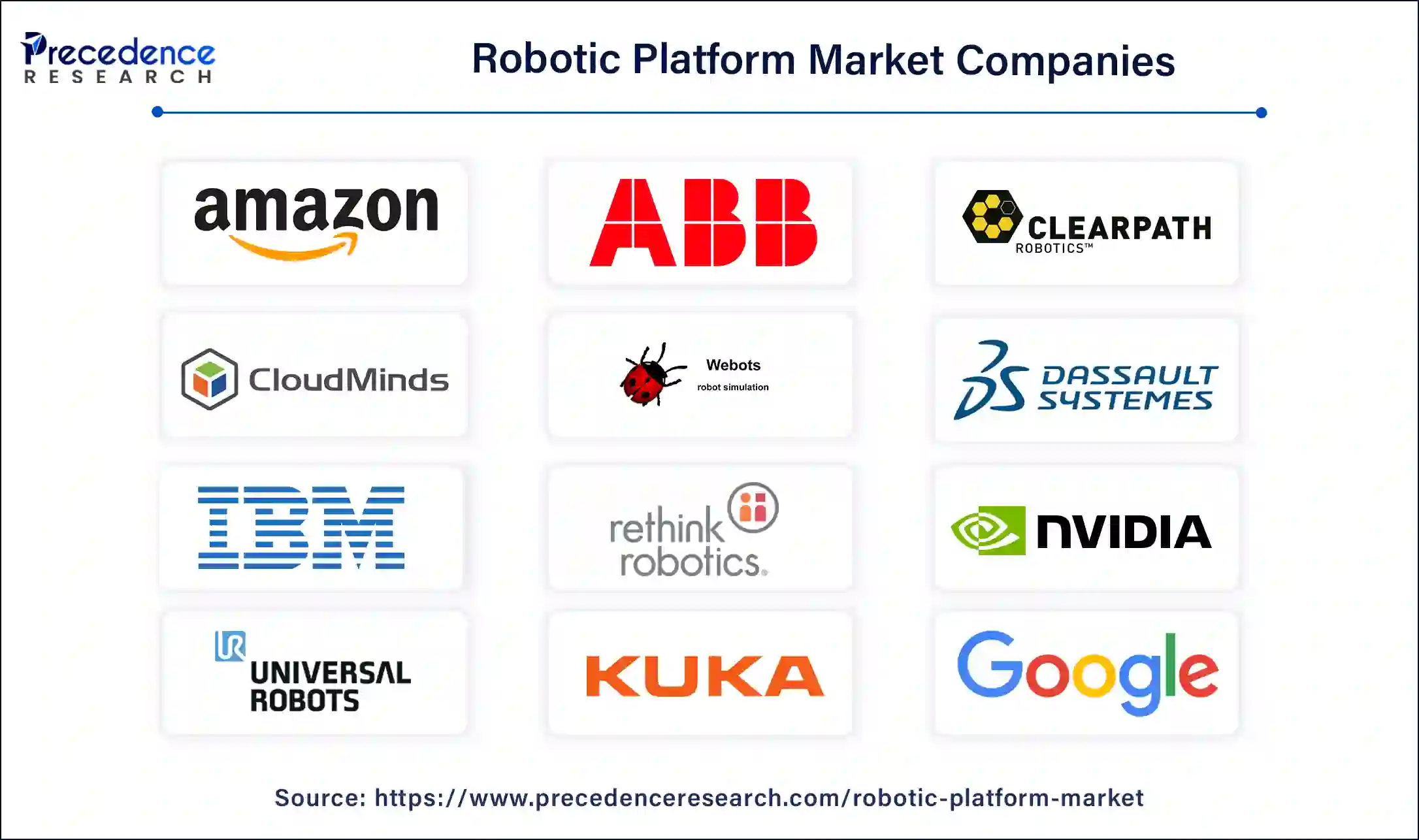
- ABB LTD.
- Amazon.com, Inc.
- Clearpath Robotics
- CloudMinds
- Cyberbotics
- Dassault Systemes
- Google LLC
- IBM Corporation
- KEBA
- KUKA AG
- Microsoft
- NVIDIA Corporation
- Rethink Robotics
- Universal Robots
Recent Developments
- In June 2024, ABB unveiled the OmniCore, a next-generation robotics control platform. OmniCore is a progression to a modern and adaptable control system that will open up opportunities for the targeted use of AI, sensor, cloud, and edge technologies to build new, sophisticated, and self-sufficient robotic solutions.
- In May 2023, Robocath launched a new robotic platform, R-One+. This platform allows the interventional cardiologist to perform coronary angioplasties by controlling the devices using an integrated control command unit located in the cath lab or the control room.
- In March 2024, IBM revealed Robotic Process Automation version 23.0.15 with improved functions and solutions. This brings about scheduling and workflow with Time Zone support as well as the use of Federal Information Processing Standards (FIPS) and intelligent User Management Services (UMS) management tools.
- In March 2024, Cognizant and Google Cloud expanded their partnership to enhance software development efficacy by embracing the Gemini platform for Google Cloud.
- In March 2024, Addverb entered into a partnership with DHL Supply Chain in North America. The partnership entails the use of 52 Zippy sorting robots and an Addverb software application in a DHL warehouse in Columbus, Ohio.
Segments Covered in the Report
By Robot Type
- Service Robots
- Industrial Robots
By Deployment
- Cloud
- On-premises
By Type
- Stationary
- Mobile
By End-user
- Manufacturing
- Electrical & Electronics
- Automotive
- Pharmaceuticals
- Food & Beverages
- Metals & Machinery
- Plastic, Rubber, and Chemicals
- Others
- Logistics and Transportation
- Healthcare
- Retail and e-commerce
- Residential
- Others
By Geography
- North America
- Asia Pacific
- Europe
- Latin America
- Middle East & Africa
For inquiries regarding discounts, bulk purchases, or customization requests, please contact us at sales@precedenceresearch.com
Frequently Asked Questions
Ask For Sample
No cookie-cutter, only authentic analysis – take the 1st step to become a Precedence Research client